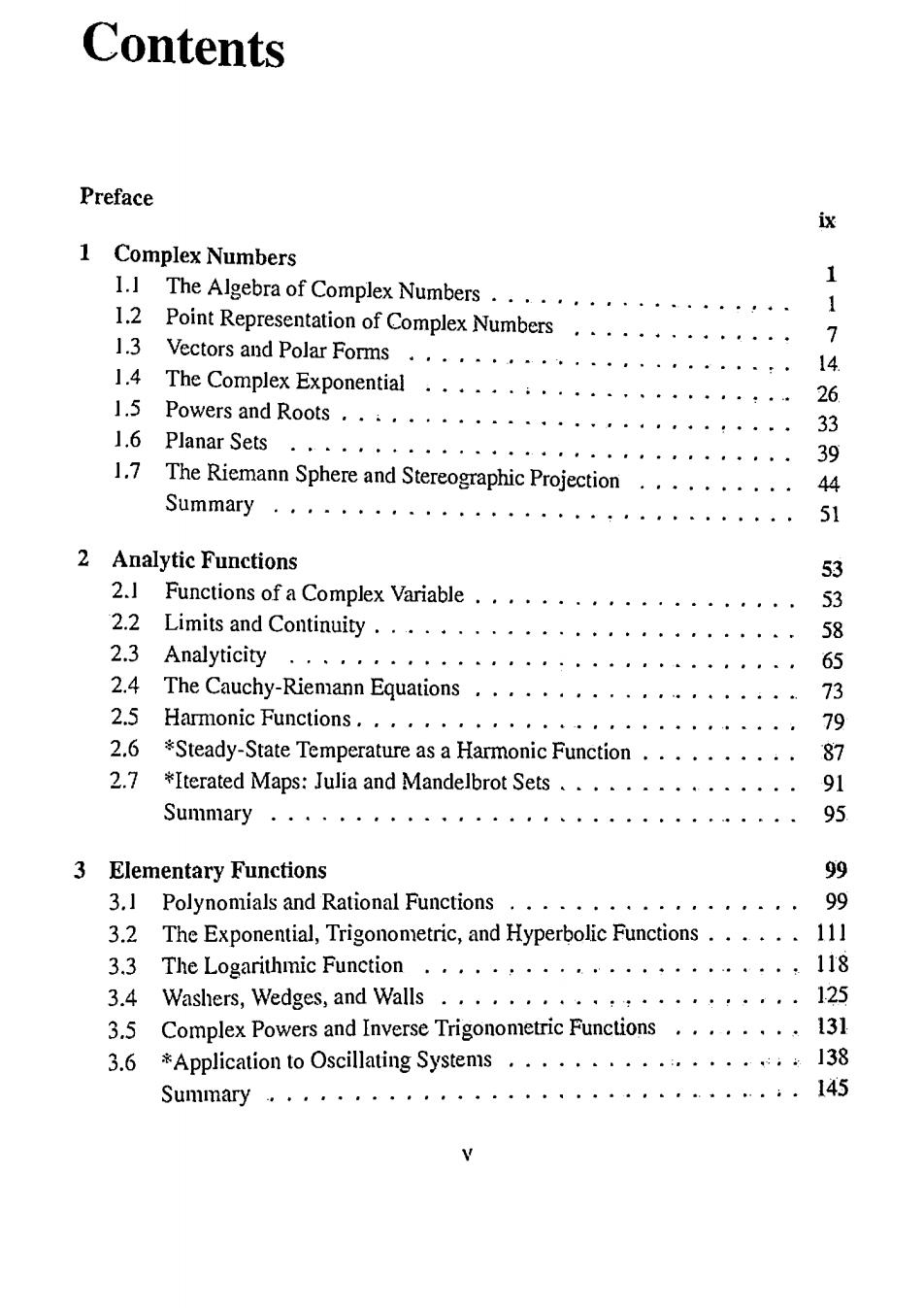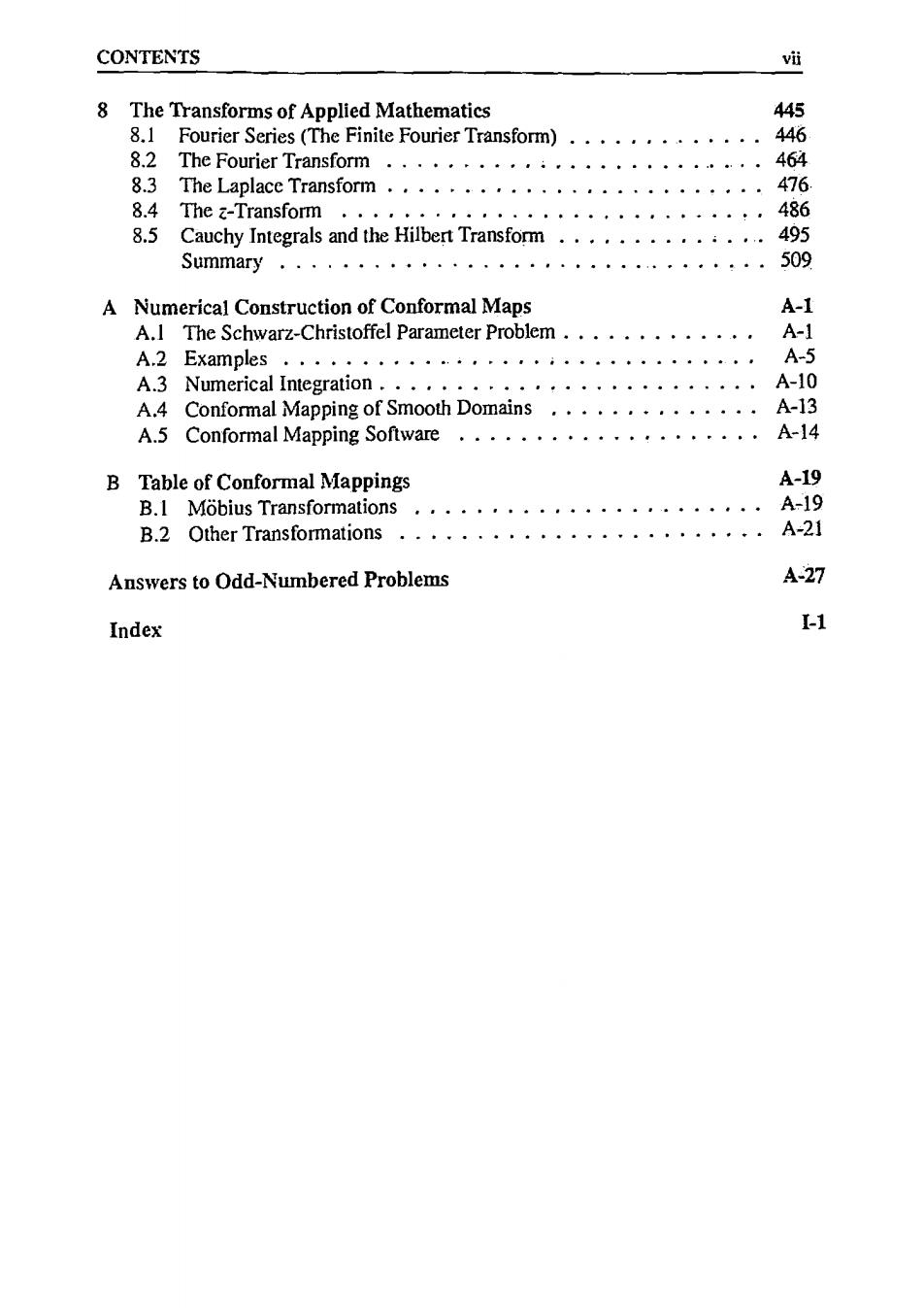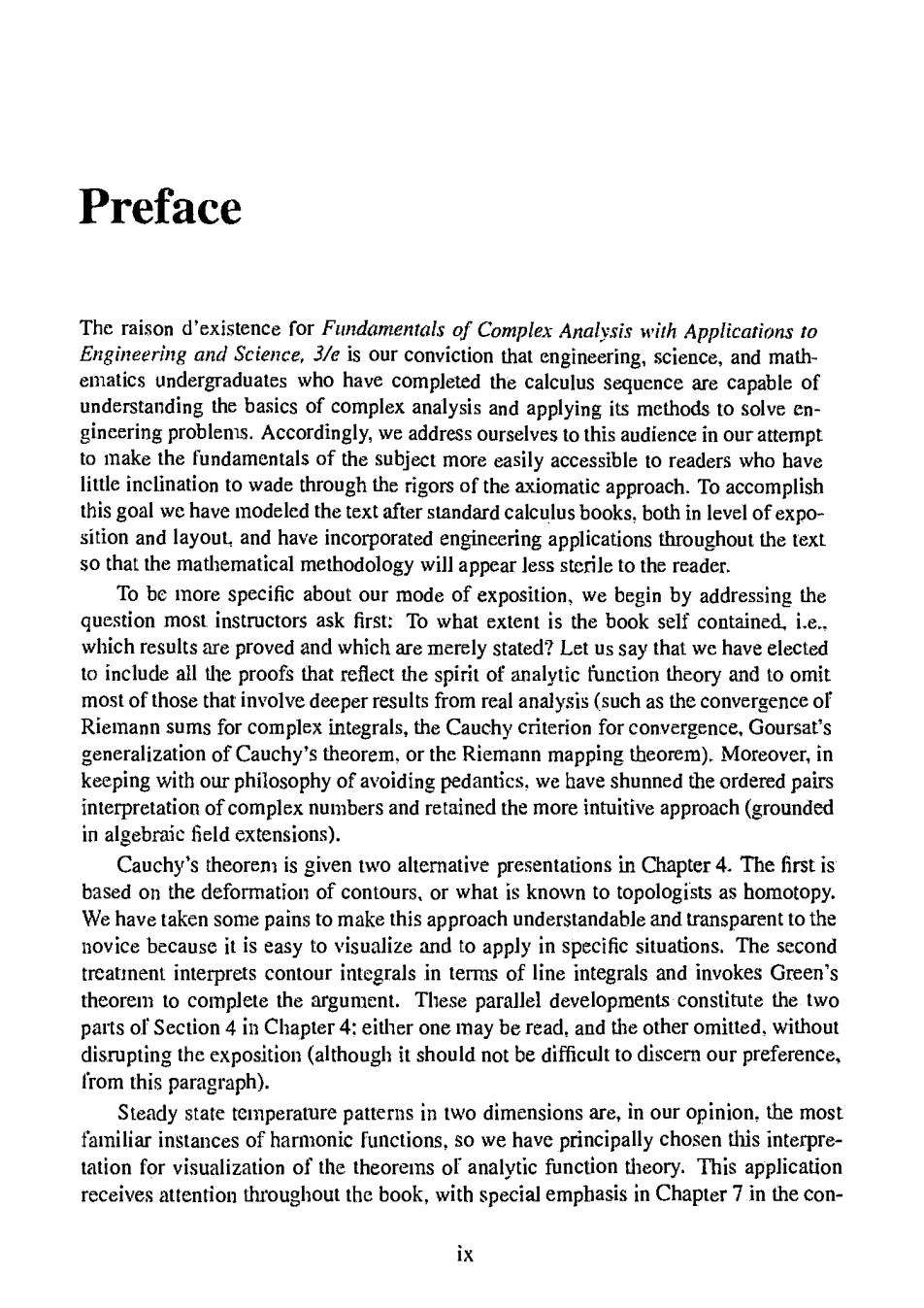
Contents Preface ix 1 Complex Numbers 1.」 The Algebra of Complex Numbers·.,.,,.,,·.· 1 1.2 Point Representation of Complex Numbers 7 .3 Vectors and Polar Forms ........ 1.4 The Complex Exponential 14 1.5 6 1.6 Powers and Roots,·:,,·················:,· Planar Sets.,·., 33 ,。。。g年g。。,年 39 1.7 The Riemann Sphere and Stereographic Projection 44 Summary 51 2 Analytic Functions 2.1 Functions of a Complex Variable.................... 53 2.2 Limits and Continuity 58 2.3 Analyticity 2.4 The Cauchy-Riemann Equations....... 73 2.5 Harmonic Functions............ 多 2.6 *Steady-State Temperature as a Harmonic Function ......... 87 2.7 *Iterated Maps:Julia and Mandelbrot Sets 91 summary 95 3 Elementary Functions 99 3.1 Polynomials and Rational Functions 99 3.2 The Exponential,Trigonometric,and Hyperbolic Functions......111 3.3 The Logarithmic Function........................118 3.4 Washers,Wedges,and Walls..................... 125 3.5 Complex Powers and Inverse Trigonometric Functions 131 3.6 *Application to Oscillating Systems 138 145

CONTENTS vi 149 4 Complex Integration 149 4.1 Contours 42 Contour Integrals 161 4.3 Independence of Path.,,.....·········· 173 180 4.4 Cauchy's Integral Theorem 4.4a Deformation of Contours Approach 180 4.46 191 Vector Analysis Approach··················· 4.5 Cauchy's Integral Formula and Its Consequences 204 214 6 Rounds for Analytic Functions,.,..······*·· 47 *Applications to Harmonic Functions········· 221 230 Summary 5 Series Representations for Analytic Functions 235 5.Sequences and Series,.,..·..·················· 235 5.2 Taylor Series 242 5.3 Power Series 252 5.4 *Mathematical Theory of Convergence 262 5.5 Laurent series. 269 5.6 Zeros and Singularities 277 5.7 The Point at Infinity..,.....,..····...,·,,··· 287 5.8*Analytic Continuation.······················· 292 304 6 Residue Theory 307 6.1 The Residue Theorem 307 62 Trigonomctric Integrals over [0,2].................. 314 6.3 Improper Integrals of Certain Functions over(-o,∞).·.····. 318 6.4 Improper Integrals Involving Trigonometric Functions 328 6.5 Indented Contours.. 337 6.6 Integrals Involving Multiple-Valued Functions...,··,,· 345 6.7 The Argument Principle and Rouche's Theorem 355 Summary.············ 367 7 Conformal Mapping 369 7.1 Invariance of Laplace's Equation 369 7.2 Geometric Considerations 377 7.3 Mobius Transformations 7.4 Mobius Transformations,Continued 383 7.5 395 The Schwarz-Christoffel Transformation... 407 7.6 Applications in Electrostatics,Heat Flow,and Fluid Mechanics.... 7.7 Further Physical Applications of Conforma Mapping 419 432 Summary············ 443

CONTENTS 啦 8 The Transforms of Applied Mathematics 445 8.1 Fourier Series(The Finite Fourier Transform)..········· 446 82 The Fourier Transform ”””””””。”””,。·。票·”如”” 464 8.3 The Laplace Transform 年4。。$,ggg。。年4。年g。。 476 8.4 Thez-Transform,.,,,.,,.,,.·,,..,..,.,..., 486 8.5 Cauchy Integrals and the Hilbert Transform 495 509 A Numerical Construction of Conformal Maps A-1 A.I The Schwarz-Christoffel Parameter Problem..,.·,,.·.··, A-1 A.2 Examples·· A-5 A.3 Numerical Integration A-10 A4 Conformal Mapping of Smooth Domains,,·,·,·,······ A-13 A.5 Conformal Mapping Software....................A-14 B Table of Conformal Mappings A-19 B.I Mobius Transformations,..·,,,··,····.,.···,·, A-19 B.2 Other Transformations.........·..,·,········· A-21 Answers to Odd-Numbered Problems A27 Index I-1

Preface The raison d'existence for Fundamentals of Complex Analysis with Applications to Engineering and Science,3/e is our conviction that engineering,science,and math- ematics undergraduates who have completed the calculus sequcnce are capable of understanding the basics of complex analysis and applying its methods to solve en- gincering problems.Accordingly,we address ourselves to this audience in our attempt to make the fundamentals of the subject more easily accessible to readers who hav little inclination to wade through the rigors of the axiomatic approach.To accomplish this goal we have modeled the text after standard calculus books.both in level of expo- sition and layout,and have incorporated engineering applications throughout the text so that the mathematical methodology will appear less sterile to the reader. To be more specific about our mode of exposition,we begin by addressing the question most instructors ask first:To what extent is the book self contained,i.e.. which results are proved and which are merely stated?Let us say that we have elected to include all the proofs that reflect the spirit of analytic function theory and to omit most of those that involve deeper results from real analysis(such as the convergence of Riemann sums for complex integrals,the Cauchy criterion for convergence,Goursat's generalization of Cauchy's theorem,or the Riemann mapping theorem).Moreover,in keeping with our philosophy of avoiding pedantics,we have shunned the ordered pairs interpretation of complex numbers and retained the more intuitive approach(grounded in algebraic field extensions). Cauchy's theorem is given two alternative presentations in Chapter 4.The first is based on the deformation of contours.or what is known to topologists as homotopy We have taken some pains to make this approach understandable and transparent to the novice because it is easy to visualize and to apply in specific situations.The second treatnent interprets contour integrals in terms of line integrals and invokes Green's theorem to complete the argument.These parallel developments constitute the two parts of Section 4 in Chapter 4:either one may be read.and the other omitted,without disrupting the exposition (although it should not be difficult to discern our preference, from this paragraph). Steady state temperature patterns in two dimensions are,in our opinion.the most familiar instances of harmonic functions,so we have principally chosen this interpre- tation for visualization of the theorems of analytic function theory.This application receives attention throughout the book,with special emphasis in Chapter 7 in the con-

Preface text of conformal mapping.There we draw the distinction between direct methods wherein a mapping must be constructed to solve a specific problem,and indirect meth ods that postulate a mapping and then investigate which problems it solves.In doing sowe hopeto dispel theimpression,given in manyoder books tha all applications of the technique fall in the latter category. In this third diionLN.Trefeth andT.Driscoll have updated an appendix that reflects the progress made in recent yearsonthe umerical cosruction ofcoformal mappings.A second appendix compiles a listing of some useful mappings having closed form expressions. Linear systems analysis is another application that recurs in the text.The basic ideas of frequency analysis are introduced in Chapter 3 following the study of the transcendental functions;Smith charts,circuit synthesis,and stability criteria are ad- dressed at appropriate times;and the developmentcuminates in Chapter with the exposition of the analytic-function aspects of Fourier.Mellin,Laplace,Hilbert,and transforms,including new applications in signal processing and communications.We hope thereby that our book will continue to serve the reader as a reference resource for subsequent coursework in these areas. Features of the Third Edition substance to the pragmatic concept of the"point at infinity"in complex analysis;an introduction to functional iteration and the picturesque Julia sets that thereby mani- fest themselves in the complex plane;an early exploration of the enrichment that the complex viewpoint provides in the analysis of polynomials and rational functions;and an introductory survey of harmonic function methods for calculating equilibrium tem- peratures for simple geometries.Optional sections are indicated with an asterisk so that readers can select topics of special interest.Summaries and suggested readings appear at the end of each chapter.As in previous editions,the text is distinguished by its wealth of worked-out examples that illustrate the theorems,techniques,and appli- cations of complex analysis. Instructors (and curious students)may benefit from a MATLAB toolbox developed by Francisco Carreras,available by Internet download from the web site http://ee.eng.usf.edu/people/snider2.html (click on complextools.zip).Instructions for its use are detailed in the file comp- man.doc.The toolbox provides graphic onscreen visualizations and animations of the algebraic manipulations of complex numbers and the common conformal maps,as well as a introductory guide for designing Joukowski airfoils. A downloadable.pdf file of the inevitable errata that our helpful readers report to us is also available at this site. The authors wish to acknowlege our mentors,Joseph L.Walsh and Paul Garabe dian,who have inspired our careers,and to express their gratitude toSamuel Gar- rett,our longtime colleague at the University of South Florida;to acquisitions editor